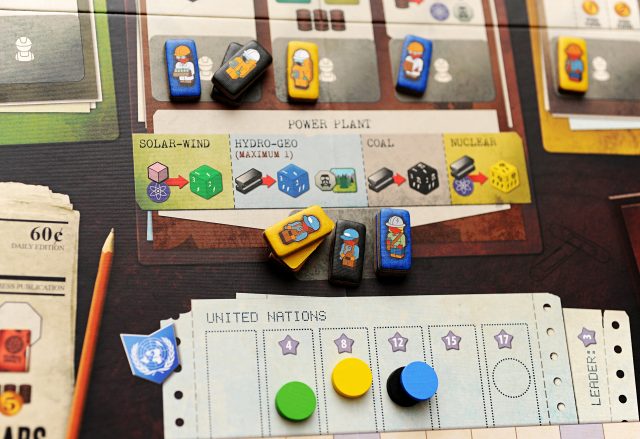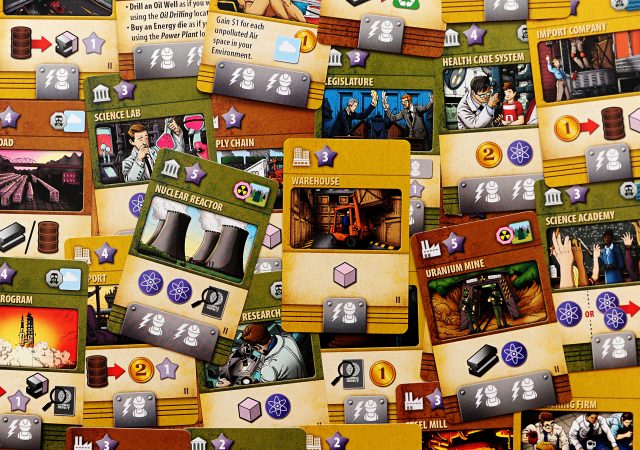When you fall in love, nothing is the same. You just want to be with that person all the time. Food tastes better, jokes are funnier, minor annoyances don’t seem to mater so much. Well, loving a board game doesn’t have such a dramatic effect on your life, but it can be an incredible feeling too. When you work in the industry, you see a lot of games. At times, playing a fun new game can feel monotonous. So when you stumble across a game that you really connect with, you want to shout it from the rooftops! Ok, enough preamble. This is Energy Empire.
I was new to the Manhattan Project series, so didn’t really have any idea what I was in for with Energy Empire, when I sat down to a game at Breakout Con.
In Energy Empire, players are the heads of different nations trying to build up heir energy industry, while (hopefully) keeping  their environment clean. Rather than being round-based, the game is completely turn-based. There are six stacks of pollution tokens that work as a timer. Whenever one stack is exhausted, a Global Impact is triggered, but then play continues as normal. This aspect leads to really smooth gameplay, and relatively short games for experienced players.
their environment clean. Rather than being round-based, the game is completely turn-based. There are six stacks of pollution tokens that work as a timer. Whenever one stack is exhausted, a Global Impact is triggered, but then play continues as normal. This aspect leads to really smooth gameplay, and relatively short games for experienced players.
Each nation starts off with their own unique set of resources (oil, plastic, steel, science, money), workers (most start with three, but some get an extra one), and Energy Dice (only a couple nations start with one).
On a turn a player will either choose to Work or to Generate. Working means placing a worker out on one of the 13 spaces on the main board and getting the action associated with that space, classic worker placement style. The board is divided into three different sections: Government, Industry, and Commerce. You’ll be able to take actions to build power plants (earning you Energy dice, but we’ll talk about that later), make money, clean up your environment, buy oil wells, and many other things.
One of the actions you can take is to buy a building from one of the different sections. The buildings are represented on cards and there are always three available in each section. When you buy a building like an Engineering Firm, Materials Research, or Oil Pipeline, it becomes part of your country’s operation. Buildings are worth end game points, but they can also be activated to give you bonuses when you take the work action. For example if you send a worker to the Commerce section of the main  board on a Work action, you can also spend energy or workers to activate all of the Commerce buildings you’ve acquired. His can lead to some massive turns if you’ve built your engine well.
board on a Work action, you can also spend energy or workers to activate all of the Commerce buildings you’ve acquired. His can lead to some massive turns if you’ve built your engine well.
Each player’s nation card also indicates a cost for advancing on the United Nations track. This is pure end game points, but it can be worth it. Multiple players can be on the same spot of the track, but only one can sneak into the 17 point space (which is actually worth 20 for having sole possession of first on the track).
The way the worker placement operates in this game is really interesting. Each nation has a staff of workers and a cache of energy, both represented by little cardboard chits. You must send a worker to the main board, but a worker or energy can be used to activate your buildings. Now is someone on the main board has taken a space that I wanted, I can still do that action. I just have to stack my worker on enough energy so that I have the highest stack for that action. Essentially, my workers have to spend more energy, the later we get to that action. Multiple people can do the same action, with each one needing to spend more energy in this fashion. You can even spend extra energy, unnecessarily to make it more expensive for the next person who wants to go there. I find this twist on worker placement really fun!
Now, eventually you’re going to run out of workers and be forced to Generate. When you Generate you can claim an Achievement (end game goal) if you have enough left over energy or workers,  then you reclaim all your workers and discard any unused energy. Here is where your Energy Dice come in to play. While you were working you may have built some power plants that come in the form of dice. There’s the environmentally friendly Solar Wind plant that yields lower energy returns, all the way up to the Nuclear plant, which generates a lot of energy but is terrible for your environment. You’re going to roll all your Energy Dice, adding in temporary Oil dice if you refine any barrels. The results will be the amount of energy you have for the proceeding turns, until you decide to Generate again. Based on the highest die result, you have to pollute your environment, taking a pollution token from the stack and adding it to your personal board in the air, land or sea section. Some die results will allow you to avoid polluting, but you’ll still have to discard a token from the stack, advancing the timer on the game.
then you reclaim all your workers and discard any unused energy. Here is where your Energy Dice come in to play. While you were working you may have built some power plants that come in the form of dice. There’s the environmentally friendly Solar Wind plant that yields lower energy returns, all the way up to the Nuclear plant, which generates a lot of energy but is terrible for your environment. You’re going to roll all your Energy Dice, adding in temporary Oil dice if you refine any barrels. The results will be the amount of energy you have for the proceeding turns, until you decide to Generate again. Based on the highest die result, you have to pollute your environment, taking a pollution token from the stack and adding it to your personal board in the air, land or sea section. Some die results will allow you to avoid polluting, but you’ll still have to discard a token from the stack, advancing the timer on the game.
For each of the pollution stacks, here is a Global Impact card. When the stack runs out, the card is revealed and three things happen. First, players will score points for one of the environment sections on their board, either air, land or sea (keeping your environment clean is a good idea). Next, one of the sets of building cards will be swept and replaced. Finally, there will be some event that impacts all he players. Sometimes, especially early in the game, it’s positive. Later in he game it can be something nasty. Once the last pollution stack runs out, game end is triggered, and every player gets on more turn.
Players will earn points for the buildings they have, the Energy Dice they’ve collected, their position on the United Nations track, their Achievements, and how clean their environment is.
Now, when you first learn this game, it feels like there is a lot going on, and there is, but the way it all flows together is amazing. There is a natural progression to the game that makes I very intuitive. The game design by Luke Laurie and Tom Jolly is super tight, and hats off to the graphics and rulebook by Josh Cappel. It makes learning this relatively complicated  game fairly simple, even from the book.
game fairly simple, even from the book.
I’d be remiss not to mention the incredible art and components of this game. The board is easy to follow and interpret, the little cardboard workers and energy tiles are cool and very functional. But it’s the amazing resources that take the cake. The oil barrels are…oil barrels, the plastics are little translucent cubes, and the steel are little silver girders. Things like this are what take a really good game and make it that much better!
So what’s so great about Energy Empire? I find it to be fun and intuitive, with lots of different paths to victory, and a brisk pace to the game as well. There is a great deal of satisfaction in creating a synergy with your nation’s engine, and the pressure to keep your environment clean affects both your conscience and your point total. More than anything though, I love the theme and the fact that it has a scientific bent to it. We’re seeing that a bit more with games like Terraforming Mars, but heavily scientific themed games are too few and far between. I really love how this game comes together. It’s one I want to teach and play again and again, and in this modern world of over saturation in the games market, that’s a rarity, and something to be celebrated. Definitely give Energy Empire a try when you get the chance. I think you’ll be happy you did.
Glad to see you bring this up! I saw this game go up on Kickstarter around May of last year and it looked gorgeous. I may just have to get a copy on Amazon when I can find the cash.
Definitely worth it, especially if you play two player ever.